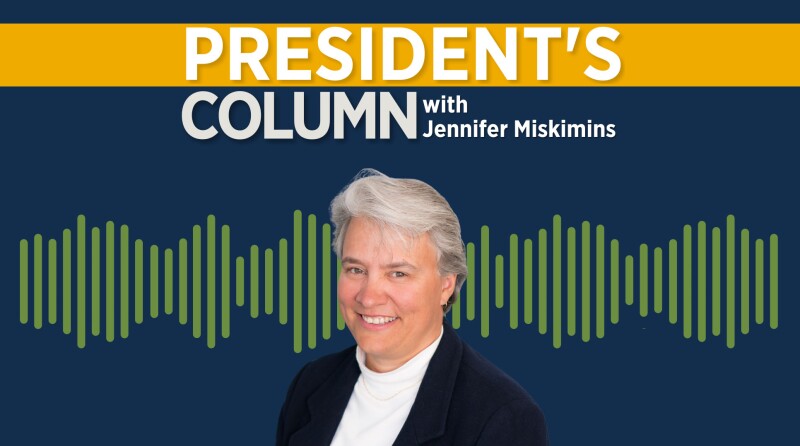I am truly honored to be the 2026 SPE International President. In a role such as this, I can’t be all things to all people, but I promise you that I will always do my upmost for the Society and its members. I will listen, I will be transparent, I will be available, and I will always strive to improve SPE for its membership in any way that I can.
I look forward to communicating with you as members via these monthly columns and the mini‑podcasts that will accompany them, but please also feel free to reach out to me at president@spe.org or via LinkedIn.
In this first column, I want to follow up on some things I’ve been asked about as I’ve assumed this role, as well as expand on a few initiatives and tasks I’d like to accomplish this year. To do so, I’m going to start with perhaps a unique topic to set the stage—taglines.
Just Do It
According to the Merriam-Webster dictionary a “tagline” is defined as “a reiterated phrase identified with an individual, group, or product.” Taglines can hold different meanings around the world, highly dependent on what is being advertised and where, but some are universal.
One that seems to be reasonably well known is “Just Do It.” I would bet that the minute you read those three words, you immediately connected it with the apparel and shoe company Nike. That’s the beauty of a tagline. In a few words, one can sum up an entity, its mission, and its vision while providing tremendous insight into the core values. That’s what “Just Do It” does for Nike—the company is saying we want you to be the best you can be and help you achieve those goals by just going out and doing it (with their equipment of course).
You might have noticed (or maybe not) that SPE International has rolled out a new tagline—“Solutions. People. Energy.” Step back and think about those three words—solutions, people, energy. Doesn’t that do an incredible job of describing what SPE is all about? Let’s break it down a bit.
The world needs energy and will need more of it for the foreseeable future. This is evident no matter whose future scenario predictions you choose to consult. The International Energy Agency’s 2024 World Energy Outlook states that from 2013 to 2023, global energy demand increased 15% and needs in 2050 will be approximately 13% higher than today. ExxonMobil’s 2025 Global Energy Outlook shows an approximate 11% growth in overall global energy demand by 2050, and TotalEnergies’ Energy Outlook 2024 also indicates increasing demand by around 11–12% by 2050.
Predictions are hard, and we all know the eventual numbers will likely be different. But just considering the background factors driving these predictions, it’s easy to understand the need.
First, the world’s population is increasing. World population was 8 billion in 2022, and the United Nations expects it to reach 9 billion by 2037. Next, energy poverty is real and affects all of us. Approximately 660 million people do not have access to electricity, and 2.3 billion people do not have access to clean cooking techniques. These are the types of numbers that illustrate why the energy trilemma—ensuring energy is equitable, secure, and sustainable—is so important. Then factor in the increasing needs predicted for AI, data centers, and other forms of growing technologies, and it is easy to see that energy transition is much more about energy expansion. We are going to need more energy in the future. Period.
These are big problems; however, where you have problems, there are opportunities, which leads us to the next portion of the tagline—solutions. New solutions are needed to supply these levels of energy in the most sustainable and carbon-neutral ways possible. Net zero does not mean no production. It means that we need to continue to find new ways to supply the energy needed, but in continuously more sustainable ways.

SPE members are creative, tenacious, and like to solve problems. We won’t be able to contribute to all areas of the required energy mix, but there are several that fall into the areas that SPE members do best. Referring to Fig. 1, which shows the new SPE classifications that 2025 SPE President Olivier Houzé outlined in his August 2025 JPT column, the core areas of oil and gas production will continue to be critical, but the low-carbon and new energy areas such as CCUS, emissions reductions, geothermal, etc. are also required to solve the world’s energy trilemma. These are all areas where SPE members are extremely capable of contributing to solving the world’s energy problems and needs.
Lastly, SPE is made up of people—smart people, talented people, people who can provide the solutions needed to supply the amount of energy that will be required. SPE is a member-driven society that, from its beginning, has connected people, helped them advance their technical and professional skills, and aided in the dissemination of technology—and it will continue to do so, as emphasized by the tagline.
Now, for any conspiracy theorists out there: no, this is not a subtle way to start changing the name of SPE. In fact, numerous tagline options were eliminated by the SPE Board of Directors because they sounded too much like a potential name change. It is exactly what it is portrayed and intended to be—a tagline that helps quickly and succinctly provide people around the globe with an image of what SPE is all about.
I have the SPE Mission printed on the back of my SPE business cards, but there is no way that I could recite it verbatim to anyone. But I can remember Solutions. People. Energy. and can quickly explain it to someone who knows nothing about SPE or the energy our members provide to the world by reciting the tagline and adding a little context to it. As a current university professor, I have already seen the benefits of the tagline in exciting students about the difference they can make in the world by joining this industry and helping develop the solutions required for our current and future energy needs!
Plans for 2026
So, the reason for the lesson on taglines, as well as for introducing SPE’s to you if you hadn’t previously seen it, is that I am using the tagline to help set the stage for my plans for 2026. I believe it does a great job of showcasing SPE, and I’m leaning into it fully. If you see a presentation from me this year, the title slide with likely say “Energizing Tomorrow: Solutions. People. Energy.” So, let’s dive into what I mean by that.
As discussed above there is no doubt that demand is and will continue to go up, yet I would argue that many people in the world have no idea where it comes from, how it arrives in their homes or powers their vehicles, or just what the future of energy looks like. I’m not trying to be patronizing, just realistic. I think most SPE members have probably run into situations where people challenge or question what they do as a profession and generally in a negative way. Now, let me be clear here—SPE is a 501(c)(3) not-for-profit organization, and we cannot lobby on behalf of the organization or its members. Additionally, given the worldwide reach of SPE, lobbying for one side might inadvertently mean lobbying against another.
But that doesn’t mean that we cannot discuss ways to speak with the general public to provide them with insight into the importance of energy in their daily lives as well as improving the standard of living to all through access to energy. Notice that I used the word “with” the general public and not “to” which is a key component of having this dialogue. Such dialogues can help to improve public perception of what we do for the world on an everyday basis, but they can be challenging and difficult. Therefore, throughout the year, I will be working to provide some tools that will hopefully help with these discussions and show the pride that we have in what we do.
Next, SPE is a member-driven society; in other words, SPE is people—not an object. As such, I want to focus on what our members need from SPE into the future, as well as what it is going to take to continue to fill the pipeline both for SPE and our industry.
2025 President Houzé has very clearly shown the cliff that we are headed for regarding Young Professional membership in SPE and what that might mean for the future of the Society. As a professor, I see the extreme hesitancy that young people have in wanting to work in the energy sector. Neither of these trends bode well for our industry.
Some of you might have seen, and/or responded to, my recent post on LinkedIn asking about what you as a member want to hear about from an SPE President in these columns. The results were very insightful—those shared both publicly and privately—and similar to those from SPE’s extended member survey in early 2024, which strongly shaped my aspirations. As such, I will have a focus in the coming year on things like upskilling the current workforce while attracting the next generations, continued career development for all career stages, technology transfer for members no matter location or company size, and global diversity and inclusion needs. (And if you didn’t have a chance to weigh in on your thoughts before, I refer you to the contact information mentioned at the start of this column.)
Turning to some operational topics, as you may have seen in the SPE Officers editorial published in JPT on 23 September 2025, SPE has had to make significant changes to its budgetary structure due to challenging financial situations post-pandemic and industry downturns including earlier this calendar year.
2025 SPE President Houzé emphasized in several of his JPT president’s columns and presentations to members that SPE’s financial position had deteriorated, and that the Board of Directors has taken multiple steps to stabilize the Society’s financial situation. This work is not yet entirely complete, and during my term, I will continue working with the Board and SPE staff to make sure the groundwork is laid and stabilized for the long-term future of the Society. This effort is constant, ongoing, and always happening in the background to maintain SPE’s solid foundation.
Finally, not just my goal, but SPE’s goal in general, is the creation of a new strategic plan for the Society. SPE strives to develop a new strategic plan every 3 to 5 years, with the most recent being developed in 2023. While on the shorter end of that time frame, the development of a new plan in 2026 is extremely timely for a variety of reasons.
As noted in the referenced SPE Officers editorial, SPE is undergoing an in-depth review of its events structure. Additionally, staff reductions are being implemented, and some member programs have been modified or, unfortunately, eliminated. Many data points indicate that membership will either stabilize or possibly slightly decrease in the next few years.
After coming out of the global pandemic, we finally have a good idea of what “rightsized” means for SPE going into the near future with a balanced budget. All these components coming together indicate that now is the time to develop SPE’s strategy for the coming years.
Please keep an eye out for more information on this and for ways you can contribute and have your voice heard as the Board of Directors conducts this effort.
Again, I am extremely honored to serve as the 2026 SPE President. And while we have many challenges ahead of us, I am a person that believes challenges also lead to opportunities. With your help, I believe that we can set SPE up for a tremendous future. So, as Nike so eloquently states, let’s Just Do It!
You can contact the SPE President at President@spe.org.


